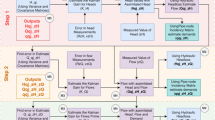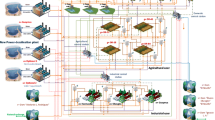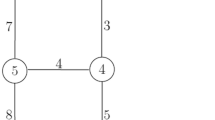Abstract
This paper deals with uncertainty estimation and knowledge enhancement in water distribution networks (WDNs). A new three steps data assimilation approach is introduced, which in combination with multi-objective optimization, allows selecting effective and affordable monitoring networks. An innovative cascade of Ensemble Kalman Filters is used to assimilate the information deriving from sensors measuring pressure heads, flow in pipes and demands, with the objective of increasing knowledge while preserving at the same time the structural relationships among state variables. Selection of the most appropriate and economically affordable measurement network, is then based on the derivation of a Pareto front using the NSGA-II algorithm in conjunction with the data assimilation approach. The front is obtained by compromising between the overall sensors cost and the uncertainty reduction (or knowledge enhancement), which is expressed as a function of the Total Variance of state variables. The operational use of the proposed data assimilation approach as well as the effectiveness of the chosen observation network is also demonstrated by showing the reduction of uncertainty deriving from successive assimilations of real-time observations.




Similar content being viewed by others
References
Alvisi S, Franchini M (2015) Assessment of predictive uncertainty within the framework of water demand forecasting using the model conditional processor (MCP). Urban Water J. doi:10.1080/1573062X.2015.1057182
Artina S, Bolognesi A, Bragalli C, D’Ambrosio C, Marchi A (2011) Comparison among best solutions of the optimal design of water distribution networks obtained with different algorithms. CCWI 2011 Urban Water Management: challenges and opportunities 3: 985-990, Exeter, ISBN: 0953914089
Basseville M, Benveniste A, Chou KC, Golden SA, Nikoukhah R, Willsky A (1992) Modeling and estimation of multiresolution stochastic processes. IEEE Trans Inf Theory 38(2):766–784
Berger JO (1985) Statistical decision theory and Bayesian analysis, 2nd edn. Springer-Verlag, New York ISBN 0-387-96098-8. MR 0804611
Bernardo JM, Smith AFM (1994) Bayesian theory. Wiley, Chichester
Chou K C (1991) A stochastic approach to multiscale signal processing. PhD dissertation, Massachusetts Institute of Technology. http://ssg.mit.edu/ssg_theses/ssg_theses_1974_1999/Chou_PhD_5_91.pdf
Cross H (1936) Analysis of flow in networks of conduits or conductors, Bulletin No. 286, Engineering Experiment Station. Univ. of Illinois, Urbana
Csardi G, Nepusz T (2006) The igraph software package for complex network research, InterJournal, Complex Systems 1695. http://igraph.sf.net
De Groot M (2004) Optimal Statistical Decisions. Wiley Classics Library (Originally published 1970), ISBN 0–471-68029-X
Deb K, Pratap A, Agrawal S, Meyarivan T (2002) A fast and elitist Multiobjective genetic algorithm: NSGA-II. IEEE Trans Evol Comput 6(2):182–197
Deng JL (1982) Control problems of Grey systems. Syst Control Lett 5:288–294
Dini M, Tabesh M (2014) A new method for simultaneous calibration of demand pattern and Hazen-Williams coefficients in water distribution systems. Water Resour Manag 28:2021–2034
Evensen G (1994) Sequential data assimilation with a non-linear quasi-geostrophic model using Monte Carlo methods to forecast error statistics. J Geophys Res 99(C5):10143–10162
Evensen G (2003) The ensemble Kalman filter: theoretical formulation and practical implementation. Ocean Dyn 53:343–367
Fiorini Morosini A, Costanzo F, Veltri P, Savić D (2014) Identification of measurement points for calibration of water distribution network models. Procedia Eng 89:693–701 16th Conference on Water Distribution System Analysis, WDSA 2014
Fortini M, Bragalli C, Artina S (2014) Identifying the High-Level Flow Model of Water Distribution Networks Using Graph Theory, 16th Conference on Water Distribution System Analysis (WDSA). http://www.sciencedirect.com/science/article/pii/S1877705814023649. https://github.com/mfortini/pyepanet2
Gordon NJ, Salmond DJ, Smith AFM (1993) Novel approach to nonlinear/non-Gaussian Bayesian state estimation. Proc Inst Elect Eng, F 140(2):107–113
Hashimoto T, Loucks DP, Stedinger J (1982) Reliability, resiliency, and vulnerability criteria for water resource system performance evaluation. Water Resour Res 18(1):14–20
Hutton C, Kapelan Z, Vamvakeridou-Lyroudia L, Savić D (2014a) Dealing with uncertainty in water distribution system models: a framework for real-time modeling and data assimilation. J Water Resour Plan Manag 140(2):169–183
Hutton CJ, Kapelan Z, Vamvakeridou-Lyroudia L, Savić D (2014b) Application of formal and informal Bayesian methods for water distribution hydraulic model calibration. J Water Resour Plann Manage. doi:10.1061/(ASCE)WR.1943-5452.0000412 04014030
Jazwinski AH (1970) Stochastic processes and filtering theory. Academic Press, New York
Julier S, Uhlmann J K (1997) A new extension of the Kalman filter to nonlinear systems. Proc. of AeroSense: The 11th Int. Symp. on Aerospace/Defence Sensing, Simulation and Controls
Kalman RE (1960) A new approach to linear filtering and prediction problems. Trans ASME J Basic Eng 82(Series D):35–45
Kalman RE, Bucy RS (1961) New results in linear filtering and prediction theory. Trans ASME J Basic Eng 83:95–108
Kapelan SZ, Savić D, Walters GA (2005) Optimal sampling design methodologies for water distribution model calibration. J Hydraul Eng 131(3):190–200
Kozelj D, Kapelan Z, Novak G, Steinman F (2014) Investigating prior parameter distributions in the inverse modelling of water distribution hydraulic models. Strojniški vestnik. J Mech Eng 60(11):725–734
Kun D, Tian-Yu L, Jun-Hui W, Jin-Song G (2015) Inversion model of water distribution systems for nodal demand calibration. J Water Resour Plann Manage. doi:10.1061/(ASCE)WR.1943-5452.0000506 04015002
Lai R, Fang H, He G (2013) Dual state-parameter optimal estimation of one-dimensional open channel model using ensemble Kalman filter. J Hydroinf 25(4):564–571
Mahler H C, Dean C G (2001) Chapter 8: Credibility In Foundations of Casualty Actuarial Science (4th ed.). Casualty Actuarial Society. pp. 525–526. ISBN 978–0–96247-622-8
McElhoe B A (1966) An assessment of the navigation and course corrections for a manned flyby of Mars or Venus. IEEE Trans Aerosp Electron Syst AES-2(4):613–623
Mehdi D, Tabesh M (2014) A new method for simultaneous calibration of demand pattern and Hazen-Williams coefficients in water distribution systems. Water Resour Manag 28:2021–2034. doi:10.1007/s11269-014-0592-4
Moradkhani H, Sorooshian S, Gupta HV, Houser PR (2005) Dual state–parameter estimation of hydrological models using ensemble Kalman filter. Adv Water Resour 28:135–147
Okeya I, Kapelan Z, Hutton C, Naga D (2014) Online modelling of water distribution system using data assimilation. Procedia Eng 70:1261–1270
Poulakis Z, Valougeorgis D, Papadimitriou C (2003) Leakage detection in water pipe networks using a Bayesian probabilistic framework. Probab Eng Mech 18:315–327
Rauch H, Tung F, Striebel C (1965) Maximum likelihood estimates of linear dynamic systems. AIAA J 3(8):1445–1450
Rossman L A (2000) EPANET 2 users manual. Rep. No. EPA/600/ R-00/057, Water Supply and Water Resources Division, National Risk Management Research Laboratory, Cincinnati.
Rougier J (2005) Probabilistic leak detection in pipelines using the mass imbalance approach. J Hydraul Res 43(5):556–566
Sanz G, Pèrez R (2014) Demand pattern calibration in water distribution networks. Procedia Eng 70:1495–1504 Proc. 12th International Conference on Computing and Control for the Water Industry, CCWI2013
Sanz G, Pèrez R (2015) Sensitivity analysis for sampling design and demand calibration in water distribution networks using the singular value decomposition. J Water Resour Plann Manage 140(10). doi:10.1061/(ASCE)WR.1943-5452.0000535 04015020
Smith GL, Schmidt SF, McGee LA (1962) Application of statistical filter theory to the optimal estimation of position and velocity on board a circumlunar vehicle. NASA Technical Report R-135, USA
Todini E (1978a) Mutually interactive state/parameter estimation (MISP) in hydrological applications. In: Vansteenkiste GC (ed) Identification and control in environ-mental systems. Elsevier, New York
Todini E (1978b) Mutually interactive state/parameter estimation (MISP). In: Chiu C-L (ed) Application of Kalman filter to hydrology, hydraulics and water resources. Univ. of Pittsburgh, Pittsburgh, pp. 135–150
Todini E, Pilati S (1988) A gradient algorithm for the analysis of pipe networks. In: Computer applications in water supply, vol 1—systems analysis and simulation. Research Studies Press Ltd., Letchworth, Hertfordshire, pp 1–20
Todini E, Rossman L (2013) Unified framework for deriving simultaneous equation algorithms for water distribution networks. J Hydraul Eng 139(5):511–526
van der Merwe R, de Freitas JFG, Doucet A, Wan E (2000) The unscented particle filter, Tech. Rep. CUED/F- INFENG/TR 380. Cambridge Univ. Engineering Dept., Cambridge
Wagner JM, Shamir U, Marks DH (1988) Water distribution reliability: simulation methods. J Water Resour Plan Manag 114(3):276–294
Wan E, van der Merwe R (2001) The unscented Kalman filter. In: S. H (ed) Kalman filtering and neural networks (chap. 7). Wiley, New York
Weiss NA (2006) A course in probability. Addison–Wesley, Boston, pp. 385–386
Wiener N (1949) Extrapolation, interpolation, and smoothing of stationary time series. Wiley, New York ISBN 0–262–73005-7
Wu ZY, Clark C (2009) Evolving effective hydraulic model for municipal water systems. Water Resour Manag 23:117–136. doi:10.1007/s11269-008-9267-3
Zadeh LA (1965) Fuzzy sets. Inf Control 8(3):338–353
Author information
Authors and Affiliations
Corresponding author
Appendix
Appendix
- H :
-
nodal pressure heads vector
- H 0 :
-
known nodal pressure heads vector
- Q :
-
pipe flows vector
- q :
-
nodal demands vector
- q j :
-
nodal demands ensemble based on prior assumptions
- \( {\mathbf{H}}_{\left|{\mathbf{q}}_j\right.},{\mathbf{Q}}_{\left|{\mathbf{q}}_j\right.} \) :
-
the value of state vectors H and Q given q j
- \( {\mathbf{H}}_{\left|{\mathbf{q}}_j,{\mathbf{z}}_H\right.},{\mathbf{Q}}_{\left|{\mathbf{q}}_j,{\mathbf{z}}_H\right.},{\mathbf{q}}_{\left|{\mathbf{q}}_j,{\mathbf{z}}_H\right.} \) :
-
the value of state vectors H, Q and q given q j and measures z H
- \( {\mathbf{H}}_{\left|{\mathbf{q}}_j,{\mathbf{z}}_H,{\mathbf{z}}_Q\right.},{\mathbf{Q}}_{\left|{\mathbf{q}}_j,{\mathbf{z}}_H,{\mathbf{z}}_Q\right.},{\mathbf{q}}_{\left|{\mathbf{q}}_j,{\mathbf{z}}_H,{\mathbf{z}}_Q\right.} \) :
-
the value of state vectors H, Q and q given q j and measures z H and z Q
- \( {\mathbf{H}}_{\left|{\mathbf{q}}_j,{\mathbf{z}}_H,{\mathbf{z}}_Q,{\mathbf{z}}_q\right.},{\mathbf{Q}}_{\left|{\mathbf{q}}_j,{\mathbf{z}}_H,{\mathbf{z}}_Q,{\mathbf{z}}_q\right.},{\mathbf{q}}_{\left|{\mathbf{q}}_j,{\mathbf{z}}_H,{\mathbf{z}}_Q,{\mathbf{z}}_q\right.} \) :
-
the value of state vectors H, Q and q given q j and measures z H , z Q and z q
- A 11 :
-
diagonal matrix defined as in Todini and Pilati (1988)
- A 12, A 21, A 10 :
-
(0,1) topological incidence matrices defined as in Todini and Pilati (1988)
- \( {\boldsymbol{\upmu}}_H,{\boldsymbol{\upmu}}_Q,{\boldsymbol{\upmu}}_Q^{\hbox{'}} \) :
-
vectors of means of \( {\mathbf{H}}_{\left|{\mathbf{q}}_j\right.},{\mathbf{Q}}_{\left|{\mathbf{q}}_j,{\mathbf{z}}_H\right.},{\mathbf{Q}}_{\left|{\mathbf{q}}_j,{\mathbf{z}}_H,{\mathbf{z}}_Q\right.} \) estimation errors
- \( {\mathbf{P}}_H,{\mathbf{P}}_Q,{\mathbf{P}}_Q^{\hbox{'}} \) :
-
variance-covariance matrices of \( {\mathbf{H}}_{\left|{\mathbf{q}}_j\right.},{\mathbf{Q}}_{\left|{\mathbf{q}}_j,{\mathbf{z}}_H\right.},{\mathbf{Q}}_{\left|{\mathbf{q}}_j,{\mathbf{z}}_H,{\mathbf{z}}_Q\right.} \) estimation errors
- \( {\mathbf{K}}_H,{\mathbf{K}}_Q,{\mathbf{K}}_Q^{\hbox{'}} \) :
-
Kalman Gain matrices for state vectors \( {\mathbf{H}}_{\left|{\mathbf{q}}_j\right.},{\mathbf{Q}}_{\left|{\mathbf{q}}_j,{\mathbf{z}}_H\right.},{\mathbf{Q}}_{\left|{\mathbf{q}}_j,{\mathbf{z}}_H,{\mathbf{z}}_Q\right.} \)
- z H , z Q , z q :
-
vectors of measures relevant to state vectors H, Q and q
- M H , M Q , M q :
-
(0,1) topological matrices relating z H to H, z Q to Q and z q to q
- \( {\overset{-}{\mathbf{v}}}_{{\mathbf{z}}_H},{\overset{-}{\mathbf{v}}}_{{\mathbf{z}}_Q},{\overset{-}{\mathbf{v}}}_{{\mathbf{z}}_q} \) :
-
vectors of mean of measurement errors for state vectors H, Q and q
- \( {\mathbf{R}}_{{\mathbf{z}}_H},{\mathbf{R}}_{{\mathbf{z}}_Q},{\mathbf{R}}_{{\mathbf{z}}_q} \) :
-
variance-covariance matrices of measurement errors for state vectors H, Q and q

Rights and permissions
About this article
Cite this article
Bragalli, C., Fortini, M. & Todini, E. Enhancing Knowledge in Water Distribution Networks via Data Assimilation. Water Resour Manage 30, 3689–3706 (2016). https://doi.org/10.1007/s11269-016-1372-0
Received:
Accepted:
Published:
Issue Date:
DOI: https://doi.org/10.1007/s11269-016-1372-0




